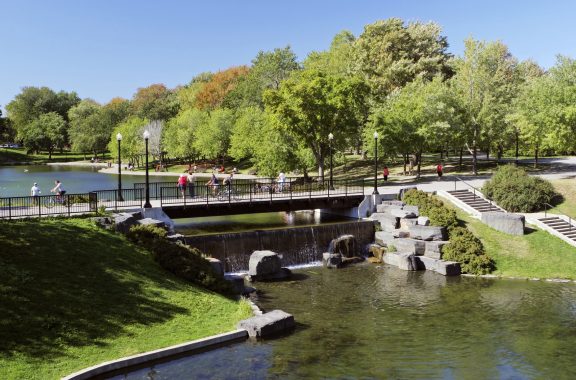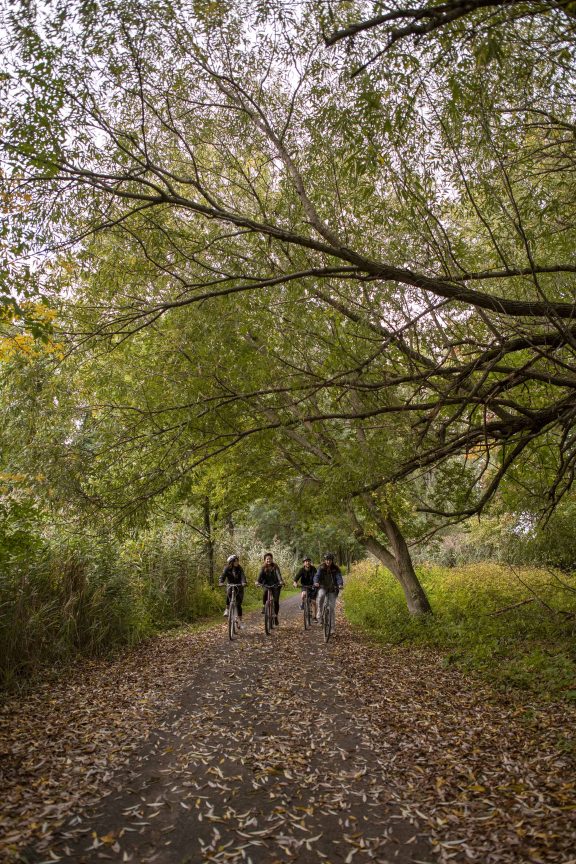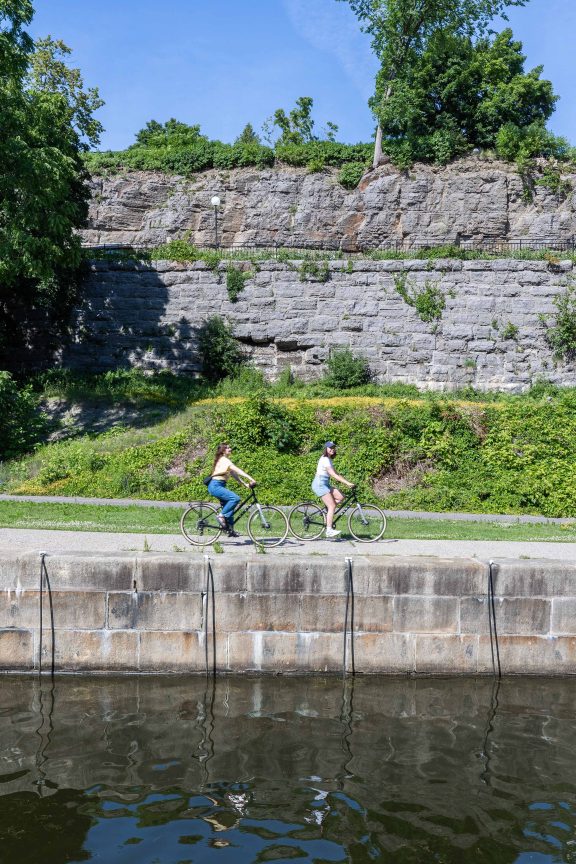10% off your next stay!
Join the Saintlo adventure and enjoy 10% off your next stay in Montreal and Ottawa.

In this article:
We in the Western World are mostly taught that being in the city means zero nature, and that the only way to connect with it is to renounce technology, hunt and forage our own food, grow a wizard beard (or build a witch coven) and live entirely off the grid. As a child reared in a hippy community, I fell prey to this thinking for many, many years (as well as believing that the Grateful Dead was a good band). That is, until I learned an open secret that Big Brother doesn’t want you to know: there are trees in the city. Birds too! And those racoons scampering the streets at dusk? Also nature. The natural world is actually, ahem, everywhere.
Montreal and Ottawa, like all modern cities, are constructed of paved roads and sidewalks, and tall buildings made of glass and steel. But pause for a moment. Do you hear the bird song when you wake up each morning from your window? Have you looked at the tree varieties bringing shade in summer, homes for countless creatures, and nourishment for the soil? Amongst the structural surfaces in Montreal and Ottawa, there are lush greenspaces, expansive parks, and a communion of city and nature unparalleled in the rest of the world. There’s no need to hitch a ride outta town to bask in its wonder. All you’ve got to do is slow down, take a few deep breaths, and look a little closer.


Sandwiched between Montreal and the suburb of Boucherville on the Saint Lawrence river, the Îles de Boucherville offer a bucket list of outdoor activities certain to soothe your mind and body. In the warmer months, you can hike the numerous marked trails, kayak and paddle board the Saint Lawrence river, or bike the island from end to end. Want to wake up to a clear view of the city? And for Snow Devotees, you’re in luck: snowshoeing and cross country skiing are offered in the winter months, which I’m told last quite a long time.
Like any outdoor space, visitors are asked to respect marked trails, avoid areas marked for conservation, and refrain from feeding the animals (my hometown seagulls got hooked on cheese crackers after being fed by teenagers and it was harrowing to witness). Simply book one of the many affordable river shuttles leaving from the Montreal Old Port to Boucherville, then grab a second to the islands. After all, don’t we all enjoy a surprise day on a boat?


The second most visited park in Canada, located a short free shuttle ride from Ottawa, Parc de Gatineau is a breath mint for the scattered mind. Think of it as an amusement park for your mental health. Visit the Pink Lake for picturesque views and family-friendly walking routes. Bring your mountain or road bike (all shuttles are equipped with bike racks) and ride under Pantone-colored falling leaves while breathing crisp, refreshing air, or simply huff it on foot through woodland wonderlands. I took it upon myself to practice the Japanese art of shinrin-yoku (aka forest bathing) while visiting Parc de Gatineau in peak fall season, and I can attest with certainty that I felt renewed after a single day trip.
Want to get away from it all but feel immersed in solitude? It’s okay! You’re safe here. Meech Creek Valley in the easternmost region of the park has far fewer crowds, postcard farmlands, spiritually cleansing trailways and an activity we all deserve to experience: stargazing.
One of Ottawa’s many flexes is that it has more gardens than you can visit in a day. But for my money, the Central Experimental Farm is the prom queen here. First off, she is free of charge, and covers over 1,600 sq. ft (for all you folks reared in the metric system, that’s approximately 488 square meters). Her centerpiece, the Dominion Arboretum is a true stunner, containing multiple greenhouses, and tree and plant varieties that would make John Muir swoon.
Traveling with a crew with a mixed bag of interests? You’ve also got heritage buildings for design aficionados, and over 100-year-old trees that have seen more tourists than Disneyland. So go ahead, touch grass! Learn about the plant life that keeps our ecosystem nourished, and return to your hometown with a wealth of unsolicited knowledge to drop at parties.
Gonna straight up brag here: Montreal is leading the way in innovative, climate-friendly park design. Sponge parks, despite my initial thinking, are not made of sponges. Worldwide, urban spaces are hard-pressed to adapt their infrastructure to a rapidly warming climate that brings erratic weather patterns. In Montreal, this means harder, more intense rainfalls.
Rather than fight this change, the city has turned to developing “sponge parks” that absorb the rainfall and use it as a feature in the parkspace, rather than spilling them into sewers or roadways. In essence, the parks breathe in the water, and exhale it into the landscape. But innovation doesn’t mean a loss of beauty. This design is not only visually appealing–it is just plain smart.
My partner and I recently visited one of the newly opened sponge parks after a visit to Segreta Pizza Al Taglio, walking across the street to devour our pizzas amongst trickling waters and lush green plants. The parks are new, not often boasting bold names or social media clout, but if you’re in for a respite within urban borders, you’re in for a treat.

Mount Royal – Officially created in 1876, this park is essentially the Grand Matriarch of Montreal parks. With countless hiking trails, panoramic views–and more Instagram spots than you can fit into a day–this park truly never disappoints. The park can be accessed numerous ways, but for my money, I recommend hoofing it on foot from Saintlo Montreal via La Montagne (a street that tells you you are heading to a mountain), passing past the Montreal Museum of Fine Arts on the way, up ancient stairs, and finally arrive at the forest path. Either hide away in the trees, or join the locals and families hiking, jogging and cycling through the fresh air. Just don’t forget to look back once you make it to the top.

Lachine Canal – Originally named as an access point for shipping boats from Montreal heading to China, the areas along the canal are now a recreational hub for city dwellers. Start at the Old Port and follow the bike/walking paths through Griffintown. Stop and take in the fall sun at many of the grassy lawns, watch the geese swimming downstream, and finish your journey at the Atwater Market, where you can stock up on locally-grown produce and Première Moisson’s unbelievable almond croissants. If you’re into people-watching, bring that paperback you’ve been meaning to devour, lay down a towel, and let the hours pass like the canal stream.

Major’s Hill Park – Gotta love a park bold enough to exist downtown. Major’s Hill park sits nestled in the heart of Ottawa, making it an easily accessible spot for those looking to touch trees (remember: forest bathing!), put their bare feet on grass or just gaze in awe at the Parliament towers. Grab a picnic lunch from nearby ByWard Market–offering an international variety of meals–and grab a table at dusklight. The city even offers an online directory of tree varieties at the park, because as we all know, travelers really want to know about trees.
These are but a few recommendations for a region absolutely overflowing with nature. As a traveler, it’s your prerogative to be a gentle guest wherever you visit, and Montreal and Ottawa are no exception. Look up local tree varieties and try and identify them walking the Centre Ville.
Listen for how many bird song varieties you can count on your hikes through the parks. There’s endless wonder to discover. All you’ve got to do is pause, breathe deeply, and take a look around.
